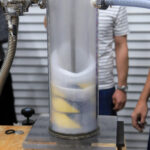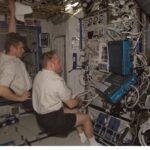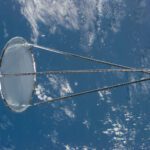Space Technology Hall of Fame Inductees
The Space Technology Hall of Fame® comprises many extraordinary innovations — all derived from or significantly improved by space research or exploration. To nominate a technology, please visit our Nominate a Technology page to learn more about the Space Technology Hall of Fame® selection criteria.
Search Filters:
Flexible aerogels were originally developed to serve as a barrier to the extreme temperatures that occur during rocket launches and that affect spacecraft as they are exposed to both high heat and severe cold. Because the initial silica aerogels were fragile and expensive, NASA contracted with James Fesmire, senior principal investigator of the Cryogenics Test…
Read MoreDLR and the private firm IQ Wireless took technology developed by DLR to analyze gases and particles in space and created a terrestrial detection tool known as FireWatch that uses high-resolution optical sensors installed on towers or masts that connect to a remote central office to monitor forests and detect potential fires. With sensors that…
Read MoreDiagnosing medical issues in space can be challenging. Traditional imaging devices like MRI and CAT Scan are much too large, heavy and energy-hungry for practical use on existing spacecraft. Alternately, compact and low-power ultrasound promises to be the diagnostic tool of choice for future human space missions. In 2000, NASA approached Dr. Scott Dulchavsky…
Read MoreA public/private partnership between NASA Glenn Research Center and SRS Technologies led to an extraordinary new product. The GATR Communication System is a portable, rapidly deployed, inflatable antenna that targets a geostationary satellite to establish critical communications for any mission scenario. In 1997, SRS Technologies (now ManTech International Technologies) received an NASA SBIR contract to…
Read MoreIn 1969, NASA invited Canada to participate in the space shuttle program. A request for proposals for a Shuttle Remote Manipulator System (SRMS) resulted in a proposal led by Spar Aerospace – now MacDonald Dettwiler and Associates (MDA) and which included CAE Electronics, RCA Canada and Dilworth, Secord, Meagher and Associates. With Canadian government support,…
Read MoreIn 1979, four countries came together to develop global approach to satellite based search-and-rescue. The United States, France, Canada and the Soviet Union agreed to jointly develop a worldwide system. By 1985, that global system known as Cospas-Sarsat was fully operational. Since its inception, this satellite based system has rescued more than 32,000 people. The…
Read MoreIn the 1960’s, Taylor Devices was awarded a NASA contract to develop a system to safely disengage hoses and mechanical gear jettisoned off of launch vehicles. These first motion dampening systems were hydraulic dampers controlled by electronic valves. While this approach safely contained the motion of the gear, the system itself was complex and prone…
Read MoreIn the late 1990’s, NASA approached the German Space Agency (DLR) to develop technology to measure the precise eye movements of astronauts aboard the Space Shuttle. A program called the “Life Sciences Working Group” was created and housed in DLR’s Division of Manned Spaceflight. DLR approached physicist Dr. Friedrich Baartz to apply his expertise in…
Read MoreDr. Alain Gachet founded Radar Technologies International in 1999 to use satellite generated remote-sensing data to identify probable locations of precious metals. Analyzing satellite data in pursuit of precious metals in the Libyan Desert, Dr. Gachet made a surprising discovery. He identified a significant water leak in the Libyan water pipeline and realized that he…
Read MoreLike so many prized finds, this discovery was unexpected. While at NASA Langley developing materials for high-speed civil transport and lightweight rocket bodies, Dr. Robert Bryant noticed that an experimental polymer that should have turned into a powder instead remained soluble. Others repeated his experiment with the same results. When Dr. Bryant left the research…
Read More






